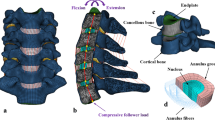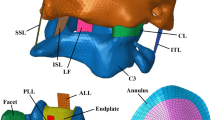Abstract
Computational and finite element models of the spine are used to investigate spine and disc mechanics. Subject specific data for the transverse profile of the disc could improve the geometric accuracy of these models. The current study aimed to develop a mathematical algorithm to describe the profile of the disc components, using subject-specific data points. Using data points measured from pictures of human intervertebral discs sectioned in the transverse plane, parametric formulae were derived that mapped the outer profile of the anulus and nucleus. The computed anulus and nucleus profile were a similar shape to the discs from which they were derived. The computed total disc area was similar to the experimental data. The nucleus:disc area ratios were sensitive to the data points defined for each disc. The developed formulae can be easily implemented to provide patient specific data for the disc profile in computational models of the spine.






Similar content being viewed by others
References
Adam C, Pearcy MJ, Askin G (2004) Patient-specific finite element analysis of single rod adolescent idiopathic scoliosis surgery. First Asian-Pacific Conference on Biomechanics, Osaka, Japan
Andriacchi T, Schultz A, Belytschko T et al (1974) A model for studies of mechanical interactions between the human spine and rib cage. J Biomech 7:497–507
Clin J, Aubin CE, Labelle H (2007) Virtual prototyping of a brace design for the correction of scoliotic deformities. Med Biol Eng Comput 45:467–473
Cohen ZA, McCarthy DM, Kwak SD et al (1999) Knee cartilage topography, thickness, and contact areas from MRI: In-vitro calibration and in-vivo measurements. Osteoarthritis Cartilage 7:95–109
Diamant I, Shahar R, Gefen A (2005) How to select the elastic modulus for cancellous bone in patient-specific continuum models of the spine. Med Biol Eng Comput 43:465–472
Duke K, Aubin CE Dansereau J et al (2005) Biomechanical simulations of scoliotic spine correction due to prone position and anaesthesia prior to surgical instrumentation. Clin Biomech (Bristol, Avon) 20:923–931
Fagan MJ, Julian S, Mohsen AM (2002) Finite element analysis in spine research. Proc Inst Mech Eng [H] 216:281–298
Fagan MJ, Julian S, Siddall DJ et al (2002) Patient-specific spine models. Part 1: Finite element analysis of the lumbar intervertebral disc—a material sensitivity study. Proc Inst Mech Eng [H] 216:299–314
Goel VK, Kim YE, Lim TH et al (1988) An analytical investigation of the mechanics of spinal instrumentation. Spine 13:1003–1011
Goto K, Tajima N, Chosa E et al (2002) Mechanical analysis of the lumbar vertebrae in a three-dimensional finite element method model in which intradiscal pressure in the nucleus pulposus was used to establish the model. J Orthop Sci 7:243–246
Gréalou L, Aubin CE, Labelle H (2002) Rib cage surgery for the treatment of scoliosis: a biomechanical study of correction mechanisms. J Orthop Res 20:1121–1128
Guan Y, Yoganandan N, Zhang J et al (2006) Validation of a clinical finite element model of the human lumbosacral spine. Med Biol Eng Comput 44:633–641
Hall LT, Esses SI, Noble PC et al (1998) Morphology of the lumbar vertebral endplates. Spine 23:1517–1522
Kumaresan S, Yoganandan N, Pintar FA et al (1999) Finite element modelling of the cervical spine: role of intervertebral disc under axial and eccentric loads. Med Eng Phys 21:689–700
Lafage V, Dubousset J, Lavaste F et al (2004) 3D finite element simulation of Cotrel-Dubousset correction. Comput Aided Surg 9:17–25
Little JP (2004) Finite element analysis of anular lesions in the intervertebral disc (doctoral thesis). Queensland University of Technology, Brisbane. Available at http://adt.library.qut.edu.au/adt-qut/public/adt-QUT20050517.141125/
Little JP, Adam C, Evans JH et al (2007) Nonlinear finite element analysis of anular lesions in the L4/5 intervertebral disc. J Biomech 40:2744–2751
Little JP, De Visser H, Pearcy MJ et al (2007) Are coupled motions in the lumbar spine largely due to the osseo-ligamentous anatomy?—a modelling study. Comput Methods Biomech Biomed Eng (Special Issue) (in press)
Mizrahi J, Silva MJ, Keaveny TM et al (1993) Finite-element stress analysis of the normal and osteoporotic lumbar vertebral body. Spine 18:2088–2096
Panjabi MM, Goel V, Oxland T et al (1992) Human lumbar vertebrae: Quantitative three-dimensional anatomy. Spine 17:299–306
Schmidt H, Heuer F, Simon U et al (2005) Application of a new calibration method for a three-dimensional finite element model of a human lumbar anulus fibrosus. Clin Biomech (Bristol Avon) 21:337–344
Teo EC, Ng HW (2001) Evaluation of the role of ligaments, facets and disc nucleus in lower cervical spine under compression and sagittal moments using finite element method. Med Eng Phys 23:155–164
Vernon-Roberts B, Fazzalari N, Manthey BA (1997) Pathogenesis of tears of the anulus investigated by multiple-level transaxial analysis of the T12–L1 disc. Spine 22:2641–2646
Viceconti M, Zannoni C, Testi D et al (1999) CT data sets surface extraction for biomechanical modelling of long bones. Comput Methods Programs Biomed 59:159–166
Zander T, Rohlmann A, Klockner C et al (2002) Comparison of the mechanical behavior of the lumbar spine following mono- and bisegmental stabilization. Clin Biomech (Bristol Avon) 17:439–445
Author information
Authors and Affiliations
Corresponding author
Rights and permissions
About this article
Cite this article
Little, J.P., Pearcy, M.J. & Pettet, G.J. Parametric equations to represent the profile of the human intervertebral disc in the transverse plane. Med Bio Eng Comput 45, 939–945 (2007). https://doi.org/10.1007/s11517-007-0242-6
Received:
Accepted:
Published:
Issue Date:
DOI: https://doi.org/10.1007/s11517-007-0242-6




